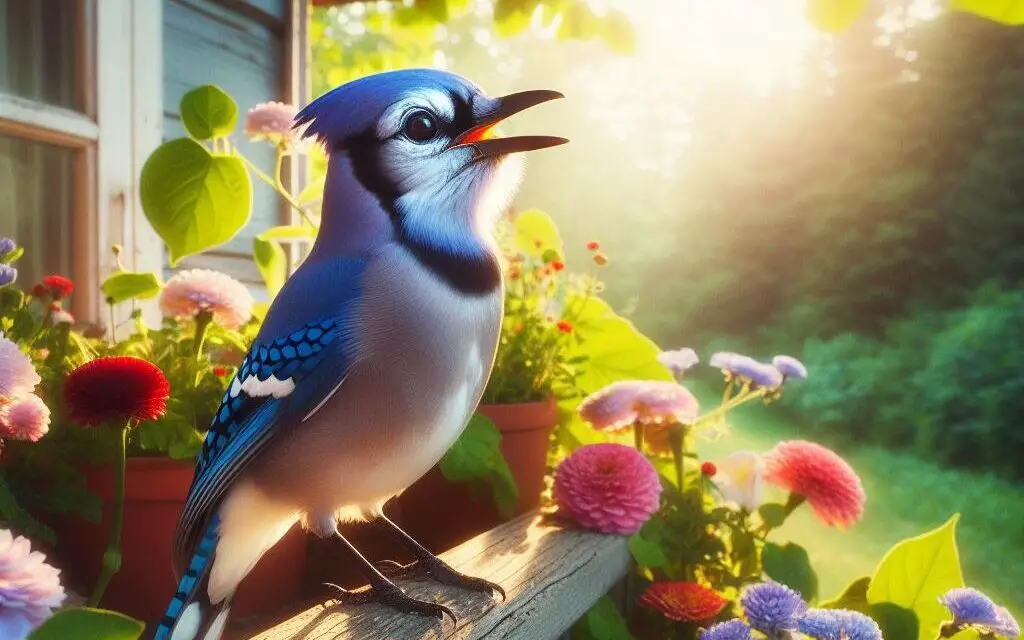Physical Address
304 North Cardinal St.
Dorchester Center, MA 02124
Physical Address
304 North Cardinal St.
Dorchester Center, MA 02124

The blue jay is one of the most recognizable and remarkable birds in North America. With its bright blue feathers and boisterous behavior, the blue jay stands out in any environment. Beyond its vibrant colors, the blue jay has many fascinating qualities worth learning about.
Here are 12 interesting facts about the beautiful blue jay:

Blue jays form extended family groups with complex social dynamics. Related females often form tightly-knit social groups while male offspring disperse further away.
Dominant breeding pairs sit atop blue jay social hierarchies. Complex behaviors like helper birds assisting with younger siblings and sentry birds sounding alarm calls showcase their sophisticated social networks.
Many researchers admire blue jays’ intelligence and behavioral flexibility. Blue jays have shown abilities to solve problems, use tools, and remember past events in experimental studies—hints of advanced thinking processes.
Beyond their brains, blue jays adapt well to various habitats like woodlands, subdivisions, and city parks. The combination of intelligence and adaptability serves blue jays well across North America.
While blue jays eat insects and other foods on occasion, seeds and nuts comprise the majority of their diet. Favorites include:
Strong bills allow them to crack open hard nuts and seeds other birds cannot. A genuine liking for nutty foods suits blue jays well, as they inhabit pine-oak forests with abundant acorns and pine nuts.
Blue jays place high value on their territory and nesting areas. As a result, they often act aggressively toward other birds and animals they perceive as threats. Dive-bombing predators and loud alarm calls represent their protective, aggressive nature.
Some research suggests increased habitat overlap with other birds due to human developments sparks rising territorial behaviors. Their feisty reputation stems from behaviors meant to protect families and ensure adequate food and shelter.
While many blue jays remain resident year-round, some populations migrate up to several hundred miles before returning home. Flocks begin migrating northward as early as February, while October sees their return from northern breeding grounds.
It remains unclear why some blue jays migrate while their close neighbors do not. Research continues investigating influences like food availability, population size, and weather patterns on blue jay migration tendencies.
Blue jays mimic the calls of predatory hawks to manipulate other birds’ behavior. Deceiving calls cause small birds to rush to hide or freeze in fear, allowing blue jays to snatch a free meal.
Mocking predators represents advanced cognitive abilities. Blue jays learn different hawk calls through experience and memory rather than pure instinct. Their ability to mimic calls convincingly highlights complex information processing akin to mimicry in parrots.

To prepare for colder months with fewer food sources, blue jays hide or “cache” nuts and seeds to recover later. A single blue jay can stash thousands of seeds and nuts each season.
Remarkably, their spatial memory allows them to recall cache locations across miles of territory and several months between hiding and recovery. This amazing recollection contributes to blue jays’ winter survival. Of course, some uneaten caches sprout into new pine, oak, and maple trees too!
Why start from scratch each breeding season when an old nest will do? Blue jay pairs frequently reuse sturdy nests built in prior years rather than building a completely new one.
Female blue jays perform most construction and maintenance on the cup-shaped, twiggy nests lined with roots and bark strips. Still, nest building requires immense effort birds seem eager to minimize when possible through reuse.
Brood parasitism involves laying eggs in the nest of another bird species to pass on parenting duties. Some blue jay populations take advantage of other birds’ nests to raise their young.
Blue jays primarily choose robin and house wren nests for dropping eggs. Unsuspecting foster parents incubate and care for blue jay chicks alongside their own. Sparing blue jays’ incubation efforts helps ensure their productivity and survival.
In 1970, Monroe County, New York, selected the blue jay as their official county bird via popular vote. Native blue jay populations and school children’s fondness for blue jays pointed to an obvious county emblem.
Their loud jay! Jay! Calls ring out across Monroe County’s parks and neighborhoods alongside red-winged blackbirds, northern cardinals, and robins. Whether residents enjoy or begrudge their company, blue jays captivate local attention.
Many Native American traditions interweave blue jays with cultural stories, symbols, and beliefs. With intelligence, loud voices, and social complexity, indigenous cultures depicted blue jays prominently.
Some Creek and Choctaw traditions portrayed blue jays as sage tricksters teaching moral lessons to people. Elsewhere, they symbolized sunlight and creation due to associations with sky and wind spirits. Regardless of specific tribes’ perspectives, blue jays held profound spiritual symbolism.
European and American literature frequently features blue jays due to their familiarity and fascination. As smart, social, aggressive birds, blue jays easily slip into fictional tales and folklore.
In Aesop’s fable “The Jay and the Peacock,” a blue jay steals a peacock’s feathers only to be scorned for lacking true beauty when returning to his flock. Beyond spotlighting vanity, the story captures Jay’s perceived trickery and thievery.
American Indian mythology and European fables cement blue jays as captivating figures in the human psyche we continually reinterpret. Their relevance persists centuries later in modern literature and pop culture.
Table summarizing interesting blue jay facts:
| Fact | Description |
|---|---|
| Complex social hierarchies | Blue jays form extended family groups with breeding pairs at the top. Helper birds and sentries demonstrate sophisticated social interactions. |
| High intelligence & adaptability | Blue jays solve problems, use tools, and have good memories. They thrive across diverse habitats from forests to city parks. |
| Mostly eat seeds & nuts | Acorns, pine nuts, sunflower seeds, and peanuts are dietary staples. Strong bills allow them to crack hard shells. |
| Aggressive tendencies | They aggressively protect territory and food sources, especially as habitats increasingly overlap with other birds. |
| Occasional migration | Some blue jay populations migrate hundreds of miles seasonally while others do not. Influencing factors remain unclear. |
| Mimic hawk calls | Blue jays trick other birds by mimicking predatory hawk calls causing them to freeze in fear, allowing blue jays to steal food. |
| Cache thousands of seeds & nuts | To survive winter, blue jays hide thousands of seeds and nuts in scattered cache sites across territories with accurate spatial recall guiding recovery months later. |
| Reuse previous nests | Nest building is difficult work, so blue jays often repair and reuse prior seasons’ nests rather than build new ones completely. |
| Practice brood parasitism | Some blue jays lay eggs in other birds’ nests, leaving them to raise blue jay chicks. This spares blue jays from incubating eggs. |
| Monroe County, NY official bird | Voted the county’s official bird in 1970 due to abundant local populations and school children’s affection. |
| Spiritual significance | Native American traditions depicted blue jays prominently in cultural symbols, stories, and spiritual beliefs. |
| Featured in folklore | European and Native American folk tales consistently portray blue jays as captivating, if mischievous, birds. |
To Native American groups, blue jays frequently symbolized sunlight, wind, and trickster spirits teaching moral lessons. Their intelligence and social bonds contributed spiritual symbolism.

On average, wild blue jays live for around 7 years with the oldest known blue jay reaching age 26. Most blue jays perish due to threats like predators, diseases, starvation rather than old age.
Partially. Northern populations migrate several hundred miles
Blue jays evolved aggressive territorial behaviors to protect limited food and nesting resources critical for supporting mates, offspring, and kin groups. As climate change and urbanization increasing force birds to overlap contested areas, aggressive encounters rise.
Their familiar loud, shrill “jay! jay!” calls ring out across forests and neighborhoods. Blue jays make a diverse array of calls including imitations of hawk calls to other birds. Mimicking predators is a cunning way to steal food from unsuspecting birds that dive for cover.
Common nest predators include squirrels, snakes, crows, raccoons, cats, opossums. Adult blue jays face threats from hawk and owl ambush attacks when moving exposed across open spaces in daylight.
Generally, no, although mated pairs cooperate each breeding season. Both male and females often seek new mates between nesting seasons, but short and long-term bonds between pairs occur. Complex social dynamics continue evolving our understanding.
Offer enticing foods like peanuts, sunflower seeds, suet, dried fruit, and mealworms. Ensure safe access to clean water sources for drinking and bathing as well. Providing natural shelters and nesting sites encourages residence too.
I hope this additional information on blue jays helps answer some common questions! Let me know if you need any other details added to the article. I’m happy to keep expanding on this as needed.

My name is Shane Warren, the author behind Your Bird Buddy – your ultimate guide to the wonderful world of birds! Unleash your inner avian explorer as we delve into a vibrant library of knowledge dedicated to all things feathered. From learning about diverse bird species from across the globe to understanding their captivating habitats and behaviors, I’m here to fuel your passion for these magnificent creatures. Not only that, but I also provide valuable insights on being a responsible and informed pet bird owner. Join our vibrant community and let’s celebrate the feathered wonders of the world together – one chirp at a time. And be sure to join our Your Bird Buddy Community over on Facebook!